Name: Mango, Aam
Scientific Name: Mangifera Indica
Adopted in: 1950
Found in: Native to South Asia; cultivated all over the world
Habitat: Terrestrial
Type: Stony Fruit
Season: Late February to early September
No. of Economically Important Cultivars: 283
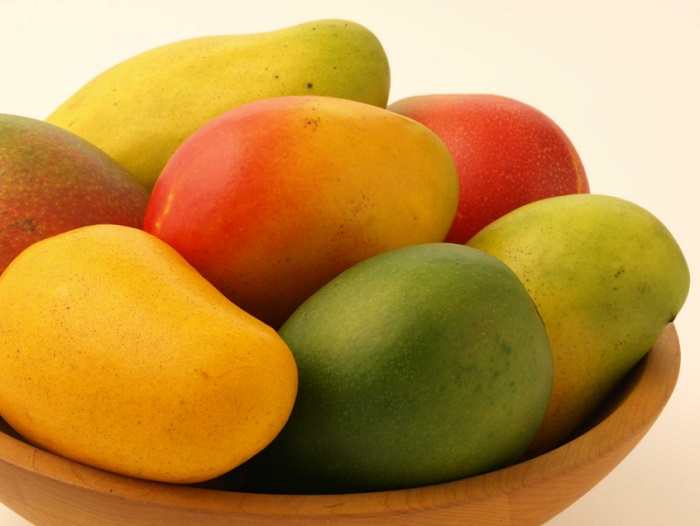
A particular fruit is designated as the national fruit of a country when it fulfills some key fundamental requirements. It must represent a powerful facet of the cultural attributes that a country wants to convey to the world. The fruit must have an enriching part in the country’s history. It should also have a considerable presence in the religious and spiritual heritage of the country. Mango, affectionately called King of Fruits is the National fruit of India. Its sweet fragrance and delectable flavors have won the hearts of many around the world. Mangoes remain one of the most cultivated tropical fruits in the world. As the national fruit of India it represents prosperity, abundance and richness in favor of the country’s image.
Mango is one of the most widely grown fruits of the tropical countries. In India, mango is cultivated almost in all parts, with the exception of hilly areas. Mango is a rich source of Vitamins A, C and D. In India, we have hundreds of varieties of mangoes. They are of different sizes, shapes and colors. Mangoes have been cultivated in India since time immemorial. Even in our mythology and history there are stories of mangoes- the famous Indian poet Kalidasa sang its praise. Alexander the great, along with Hieun Tsang savored the taste of mangoes. The great Mughal king, Akbar is said to have planted over 100,000 mango trees in Darbhanga (modern Bihar). The mango is eaten ripe and is also used for pickles.
Scientific Classification
Domain: Eukarya
Kingdom: Plantae
Subkingdom: Tracheobionta
Division: Magnoliophyta
Class: Magnoliopsida
Subclass: Rosidae
Order: Sapindales
Family: Anacardiaceae
Genus: Mangifera
Species: Mangifera Indica
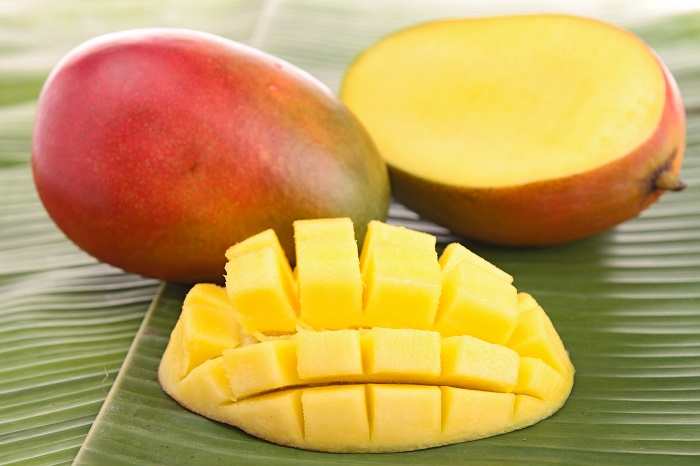
History
The pleasures of mango and its divine flavor have been known to Indians from a very early age. Fossil evidence traces back the appearance of mango in India, Bangladesh and Myanmar to 25-30 million years ago. It is referred to in Vedic scriptures like Brihadaranyaka Upanishad, the Puranas, Rasala and Sahakara. The importance of mangoes in Buddhism was underlined by the fact that Lord Buddha chose to rest under the shade of a mango tree and Buddhist monks carried mangoes with them everywhere. Alexander the Great is said to have returned to Europe with several varieties of the fruit. Foreign travellers like Megasthenes and Hsiun-Tsang heavily praised the taste of the fruit and mentioned that Mango trees were planted by Indian rulers on the side of the roads as a symbol of prosperity.
Distribution
Indian Mango or Mangifera indica is native to Southern Asia, particularly India, Bangladesh and Myanmar. Buddhist monks are believed to have introduced the fruit to southeast Asian countries like Malaysia and China around 4th century B.C. Since then it has been introduced to East Africa by the Persians, and to West Africa and Brazil by the Portuguese.
The Mano Tree, Leaves & Fruit
The mango trees are medium to large in size ranging between 10-40 m in height. They are evergreen with large symmetrically round canopy with an average diameter of 10 m. Bark is dark brown in color. Leaves are elongated and 15-45 cm in length. Upper surface is dark green with a waxy layer while the underside is pale green in color. The leaves are arranged very closely together and appear to be bunched in groups of 5 or more. Flowers are produced in terminal panicles which are about 20 cm in length. Flowers are white in color, small with 5-10 mm long petals and with a sweet odour. Unripe fruits are generally green in color but the color of the ripe fruits vary and ranges from green to yellow to orange to red. The fruits are oblong in shape and are fleshy drupes. The length of the fruit varies from 25-40 cm. Each fruit carries a flattened pit that is oval in shape and is generally fused with the flesh by means of fibrous protrusions. The pit carries the plant embryo which is recalcitrant in nature.
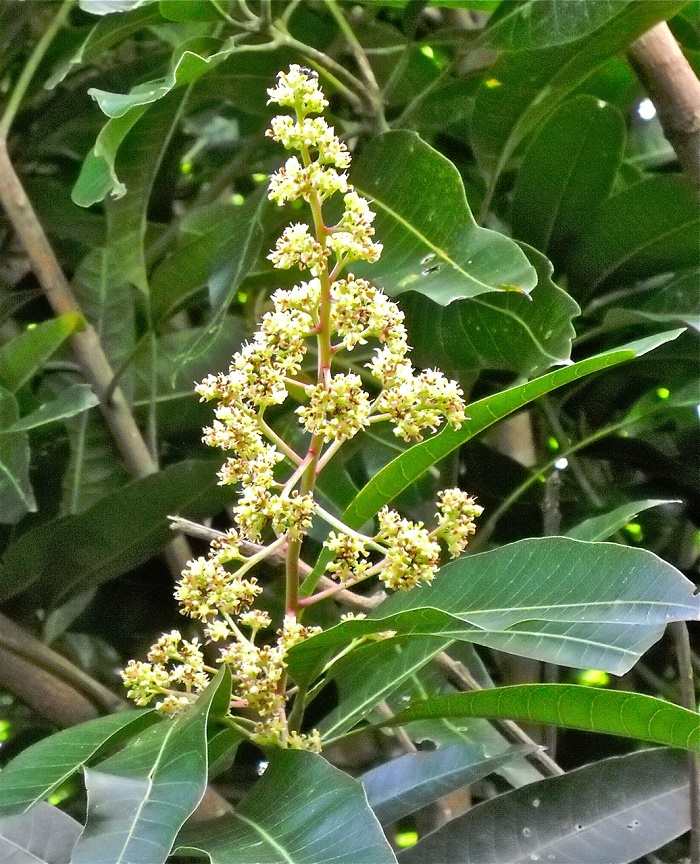
Cultivation
India leads the production of mangoes in the world with almost half the total production. In Europe, it is grown in Andalusia, Spain. In the USA, mangoes are cultivated in South Florida and California regions. The Caribbean Islands also see considerable cultivation of mangoes. In India, Andhra Pradesh state leads in production of mangoes.
Mango is generally cultivated in tropical and warmer sub-tropical climates, upto an altitude of 1400 m from sea level. Humidity, rain and frost during flowering adversely affect the productivity of mangoes. Wet monsoon and dry summer is ideal for mango cultivation. Mango trees prefer slightly acidic soil with pH ranging from 5.5-7.5. They can grow well in well-drained laterite and alluvial soil which is at least 15.24 cm deep.
Vegetative method of cultivation is preferred by farmers and techniques like inarching, veneer grafting and epicotyl grafting are employed. Well-nourished plants start bearing fruits after 3-5 years of planting, depending on the type of cultivar. Fruits are harvested between early February to August for most cultivars. Shelf life of mango fruits is short - about 2-3 weeks, hence they are stored in low temperatures of 12-13°C.
In India, around 1500 varieties of mangoes are cultivated among which 1000 are of commercial value. The most popular and well known among these are Bombai, Himsagar and Kesar from early season, Alphonso, Banganapalli and Langra from mid-season, Fazli, Neelum and Chausa from late season. Several hybrid varieties have also been introduced, eg: Amrapali (Dashheri x Neelum) and Arka Aruna (Alphonso x Banganapalli).
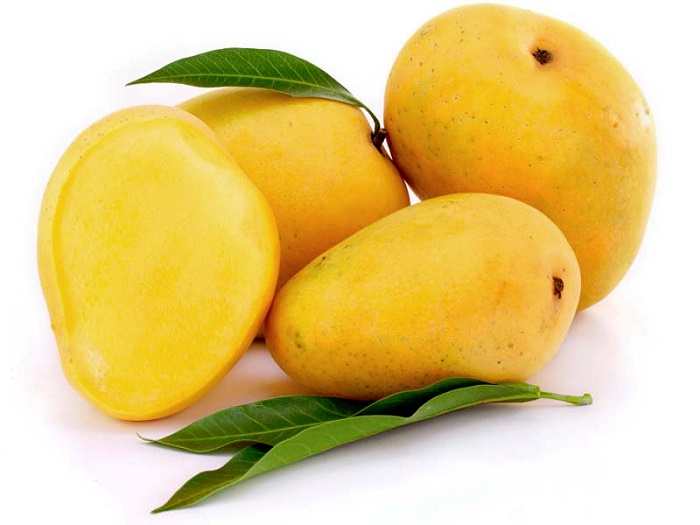
Nutrition Value
Ripe mangoes are generally sweet although some varieties can retain a sour taste even after ripening. The texture of the flesh varies across cultivars as well ranging between soft pulpy and firm or fibrous. Sour unripe mangoes are used in wide varieties of pickles and chutneys or may be eaten raw with salt and chilli. Drinks like aam panna and aamras are made from the pulps of raw and ripe mango respectively. Ripe mango pulp is used in making a number of desserts like mango kulfi, ice creams and sorbets.
Mangoes are a rich source of anti-oxidants like quercetin, astragalin and gallic acid that have been proven to fight against certain types of cancers. High levels of fiber, pectin and vitamin C helps lower low-density Lipoprotein levels in blood. Mango pulp is rich source of vitamin A that helps improve vision. Mango fruits have low glycemic index and are fit to be consumed by diabetics. The abundance of vitamins and carotenoids present in mango pulp helps boost the immune system. Consumption of mangoes is associated with decreased risk of muscle degeneration as well as asthma.
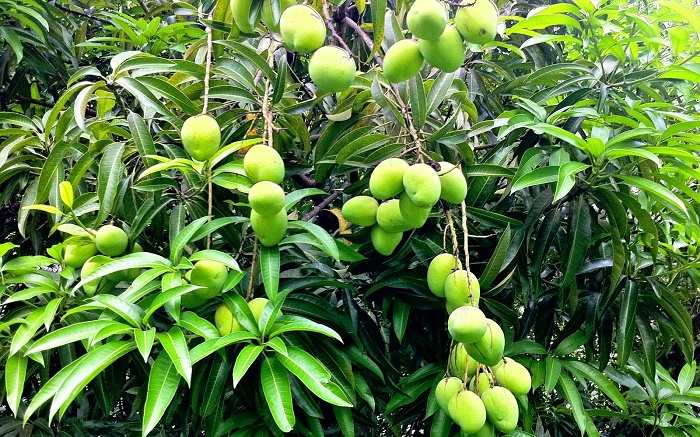
Economic Value
Mangoes are the most widely cultivated fruit in India. Wood from the mango tree is used for producing low cost furniture, packing cases etc. Tannin derived from the bark is used in leather industry. Although India leads the production of mangoes, most of it are consumed by the country’s population itself and only a small percentage is exported.
Cultural Context
From ancient times, mangoes have been granted a special position in India. The fruit is heavenly in taste and is termed as ‘Food of the Gods’. It is a source of celebration among people from all social backgrounds. A perfectly ripe mango symbolizes attainment and prosperity. Mangoes are also representative of the country’s gift to the world. Jain Goddess Ambika is depicted to be sitting under a mango tree. Mango blossoms are an integral part of Saraswati worship. Mango leaves are considered auspicious and five mango leaves joined together is a mandatory component of Hindu Rituals.



